JMS-S3000 SpiralTOF™-plus 3.0
Matrix-Assisted Laser Desorption
/Ionization Time-of-Flight
Mass Spectrometer
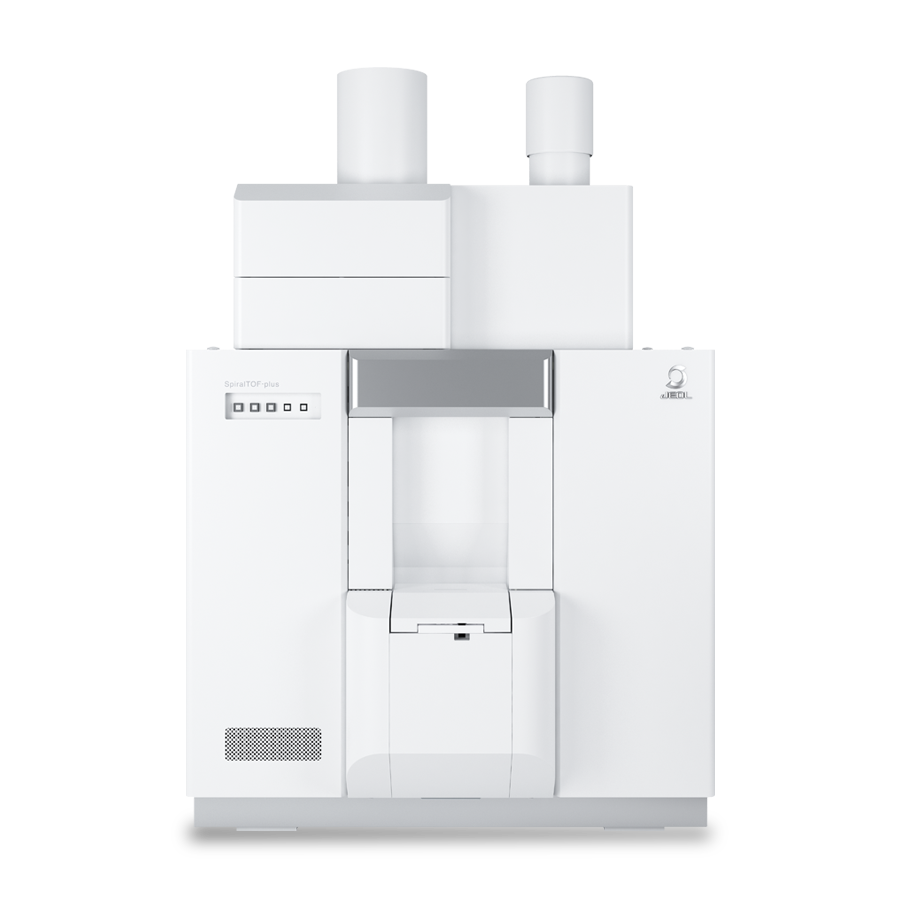
Features
◆ Clicking the Play button starts the video (approx. 4 minutes). ◆
The JMS-S3000 SpiralTOF™-plus 3.0 is a MALDI-TOFMS* that uses innovative SpiralTOF ion optics that has been updated to extend the mass range of this high resolution system. The JMS-S3000 defines a new standard in MALDI-TOFMS performance and provides state-of-the-art analytical solutions for a wide range of research areas such as functional synthetic polymers, materials science, and biomolecules.
*Matrix-Assisted Laser Desorption/Ionization Time-of-Flight Mass Spectrometer
Setting the new standard in MALDI-TOFMS performance
To improve the mass resolving power and mass accuracy of a time-of-flight mass spectrometer, the flight distance must be extended while keeping a group of ions having the same m/z (an ion packet) from diverging in space.
The innovative SpiralTOF ion optics was developed by JEOL based on the "Perfect focusing" and "Multi-turn" principles. The ion packets are focused back in space at every fixed distance (i.e., each figure-eight trajectory) during the flight. Thus, even after the extended flight distance, the ion packets do not diverge at the detection plane, achieving high mass resolving power, high mass accuracy, and high ion transmission.
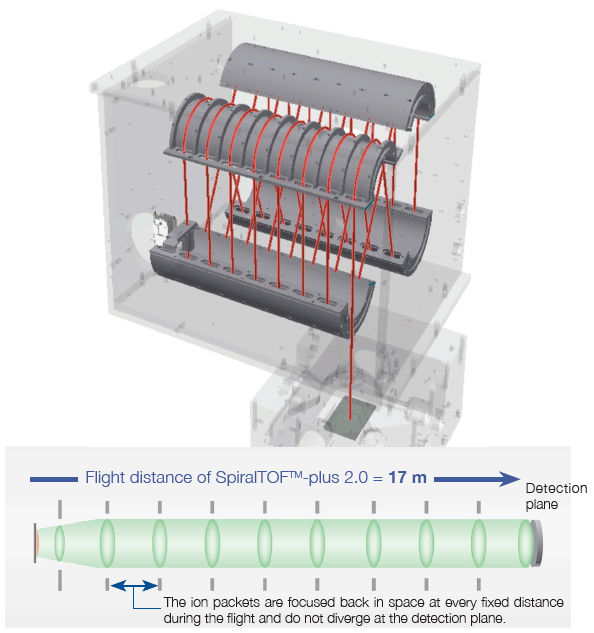
Mass resolutions observed with a mixture of peptide standards.
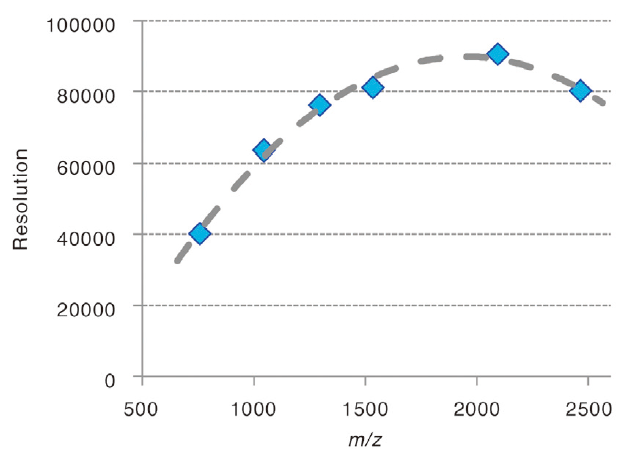
Reduced topographic effect of matrix crystal
The topographic effect of the matrix crystal leads to a difference in flight start position for the ions, resulting in a difference in flight time. In the conventional ion optical system, this time difference degrades the mass resolving power and also the mass accuracy obtained with external mass calibration. With its extended flight distance, the JMS-S3000 reduces this effect to the minimum and achieves highly reproducible mass resolving power and high mass accuracy with an external mass calibration.
Another consequence of this is that high mass-resolution and mass accuracy can be maintained for imaging analysis of a biological specimen in which a large number of mass spectra are acquired across a large specimen surface that is likely to be uneven.
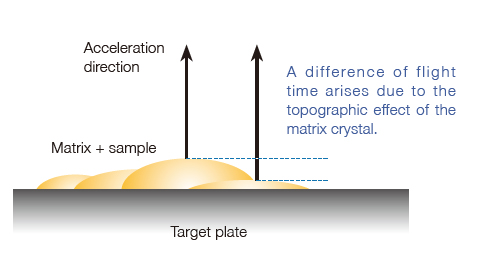
Achieving a wide dynamic range
The SpiralTOFTM-plus 3.0 has realized a wide dynamic range by employing a 14-bit ADC (Analog-to-Digital Converter) for TOF signal processing. This makes it possible to simultaneously detect peaks with ion intensity differences of about 4 orders of magnitude. Also, the analysis of trace components has become easy in mass spectrometry imaging measurements, in addition to the conventional bulk sample measurements. Below is the measurement example of a mixture of polyethylene oxide and polypropylene oxide in the ratio of 1,000:1. In the case of polymer analysis, when combined with the Kendrick Mass Defect (KMD) analysis, it is possible to analyze trace components that are otherwise difficult to detect. In the example below, the trace component PPO was detected, and its average molecular weight etc. could be calculated.
The mass spectrum of a mixture of polyethylene oxide and polypropylene oxide in the ratio of 1,000:1.
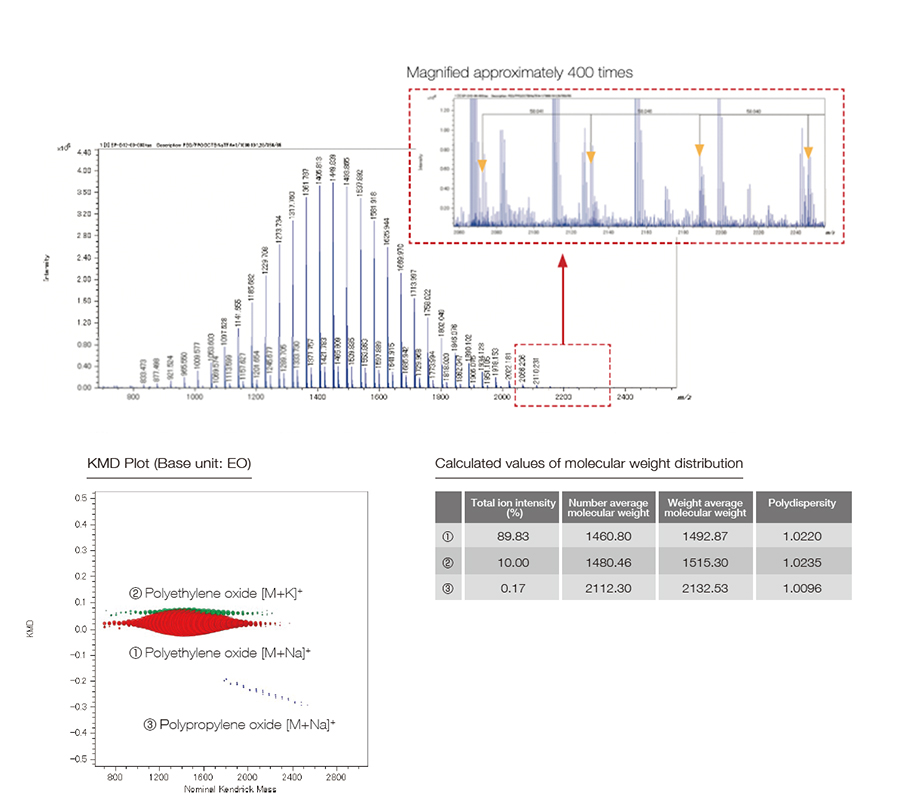
Features and usages of TOF-TOF option and linear TOF option
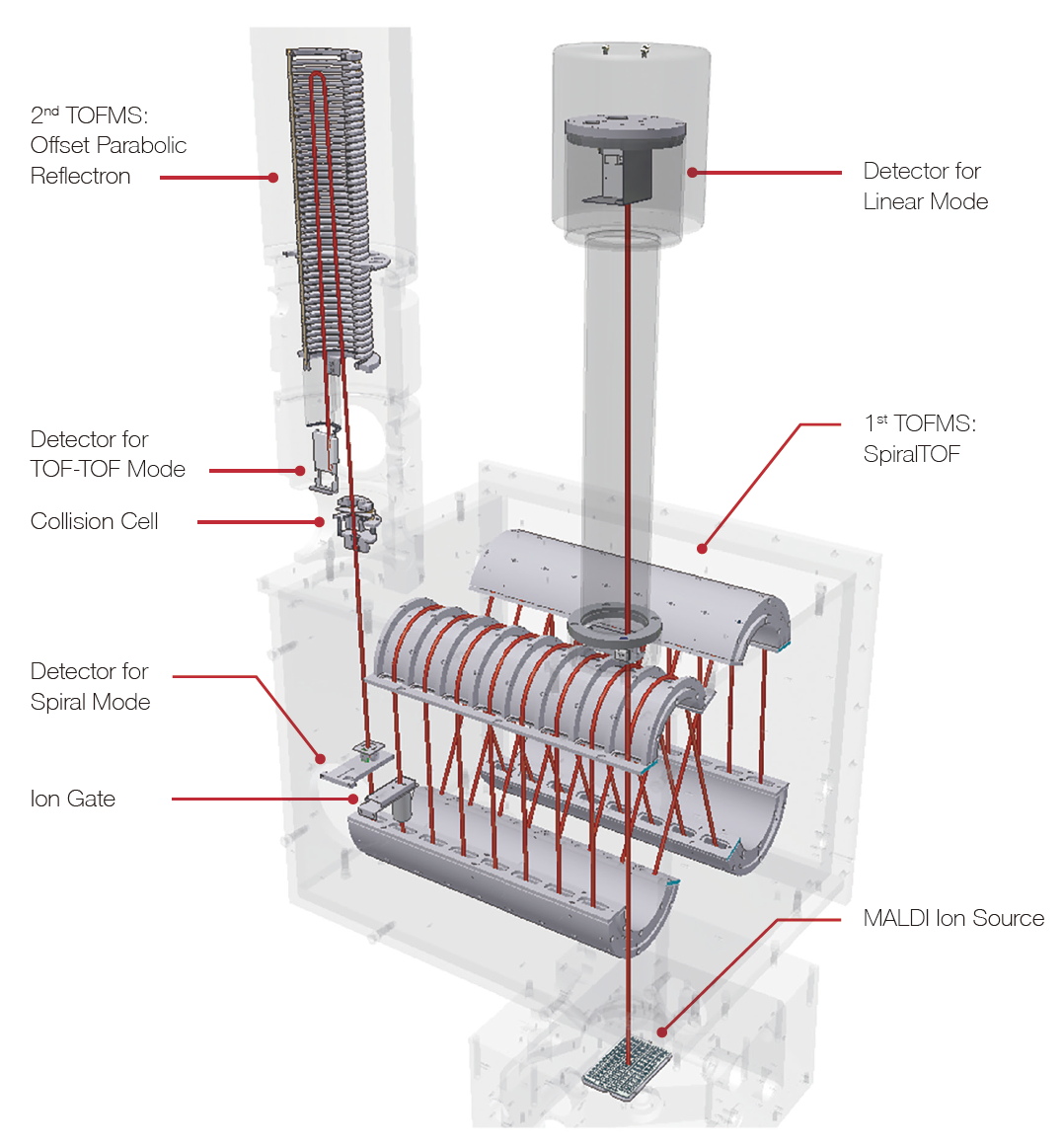
TOF-TOF option
Features
By adopting the SpiralTOF ion optics as the first MS, the high precursor ion selectivity can be realized. The monoisotopic peak of precursor ions can be properly selected.
High-energy collision-induced dissociation (HE-CID) allows for the acquisition of product ion mass spectrum rich with structural information.
JEOL's proprietary off set parabolic reflectron technology enables the acquisition of all product ion information from m/z 5 to the precursor ion, thus facilitating the production of highly reliable structural information.
Usage
In structural analysis of organic compounds, the accuracy of composition determination using accurate mass in Spiral mode can be improved by determining the adduct ion, in addition to the structural information obtained by HE-CID.
In elucidation of amino acid sequences of a peptide, distinguishing structural isomers such as leucine and isoleucine is possible, as a feature of HE-CID. It is also possible to confirm the presence / absence of amino acids in a peptide by the presence / absence of immonium ions.
For the analysis of additives, surfactants, and lipids, the structural analysis of alkyl chains is important. With HE-CID, it is possible to estimate the alkyl chain length and the positions of double bonds.
For structural analysis of polymers, it is possible to confirm the ion type (adduct ion) and the mass of the end groups from the product ion mass spectrum. Using this information with the Spiral mode elemental composition information, the accuracy can be improved even further for structure elucidation.
Product ion mass spectrum of poly(oxypropylene)
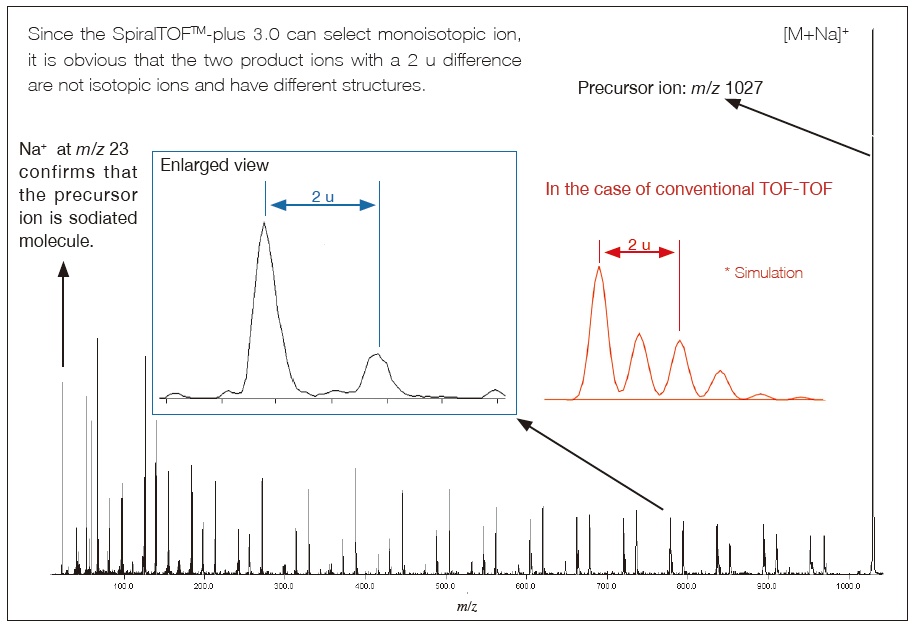
Linear TOF option
Features
In the Linear TOF option, the ions travel from the ion source to the detector unaffected.
When ions undergo post source decay (PSD) in flight, the produced fragment ions and neutrals continue to fly at the same velocity as before fragmentation. Hence, in a Linear mode mass spectrum, they are detected as the same signal as that of the ions that have not fragmented. Consequently, high molecular weight compounds that tend to undergo PSD can be measured with high sensitivity using Linear mode.
The combination of Spiral and Linear modes further expands the range of analytes that can be measured.
Usage
Useful for screening of molecular weight distribution of polymers.
It is possible to calculate the molecular weight distribution & polydispersity of polymer samples with various masses ranging from several thousands to several tens of thousands.
It is possible to measure high-mass samples of molecular weight over 10,000 Da such as intact proteins, with high sensitivity.
It enables high-sensitivity measurement of samples that can easily undergo PSD, such as proteins and polysaccharides.
Mass Spectra of Bovine Serum Albumin (BSA) and Immunoglobulin G (IgG)
The linear TOF option allows easy determination of intact protein molecular weight.
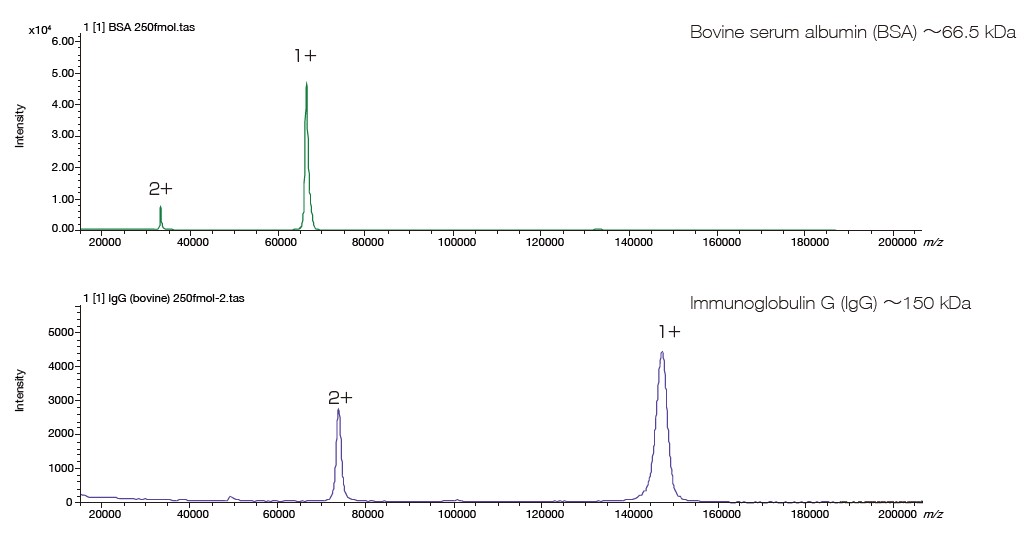
JMS-S3000 SpiralTOF™-plus 3.0 is ideal for Polymer Analysis
Industrial polymeric materials based on mixtures of polymers with different end groups or copolymers contain a wide variety of compounds. It is necessary to detect all the components in order to grasp the whole picture, which requires ultra-high mass resolution in a wide mass range. In addition, it is important to detect not only the base material but also trace components because multiple types of polymers and trace additives are blended for higher functionality.
With its wide dynamic range and ultra-high mass resolution over a wide mass range, SpiralTOF™-plus 3.0 is the solution that meets these requirements.
Elimination of post source decay (PSD) derived ions, which is a major feature of SpiralTOF ion optics, also contributes significantly to clear mass spectrum analysis.
We provide the most effective and unique solution for polymer analysis, which has become more and more complicated in recent years due to its high functionality and recycling.
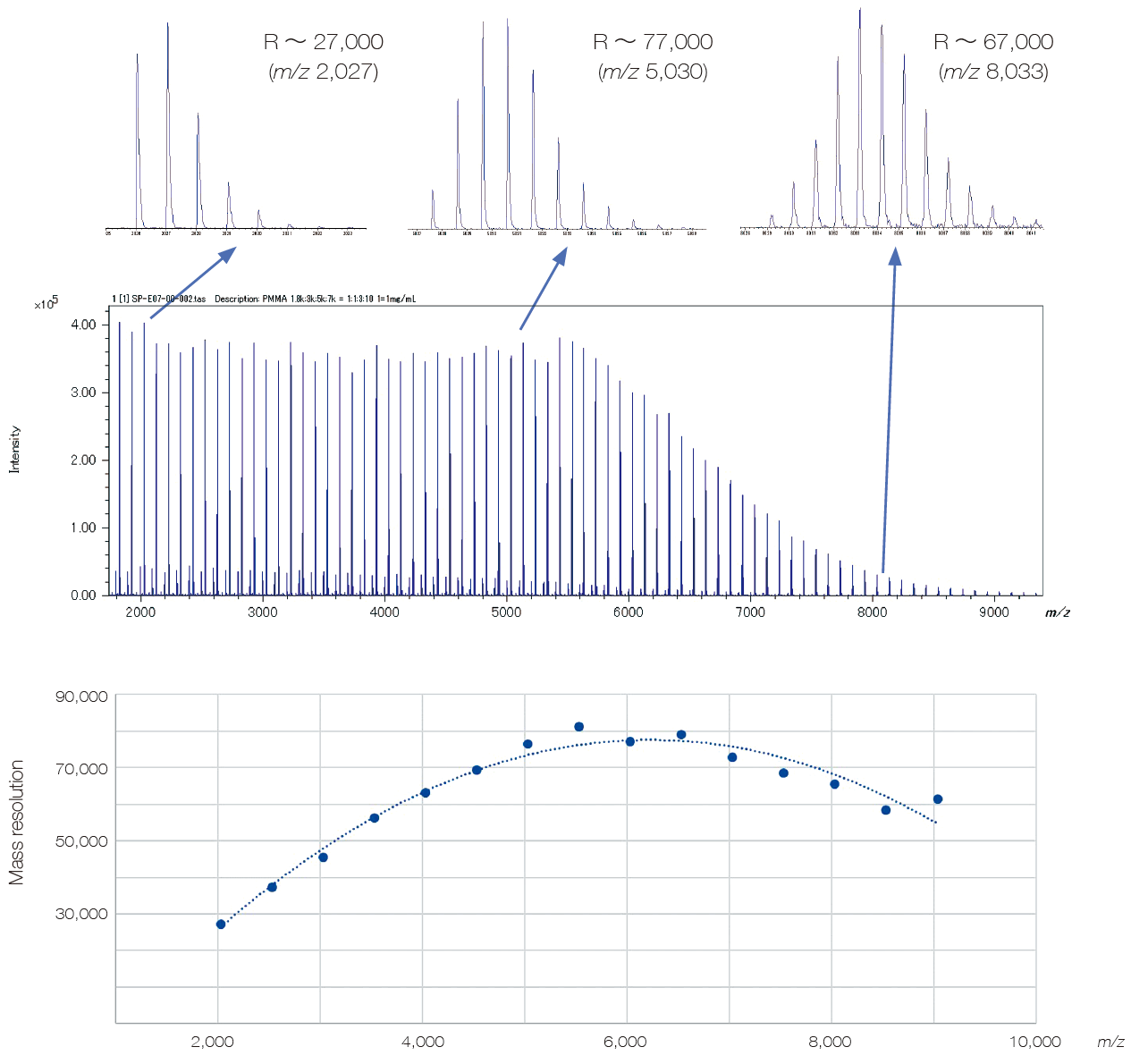
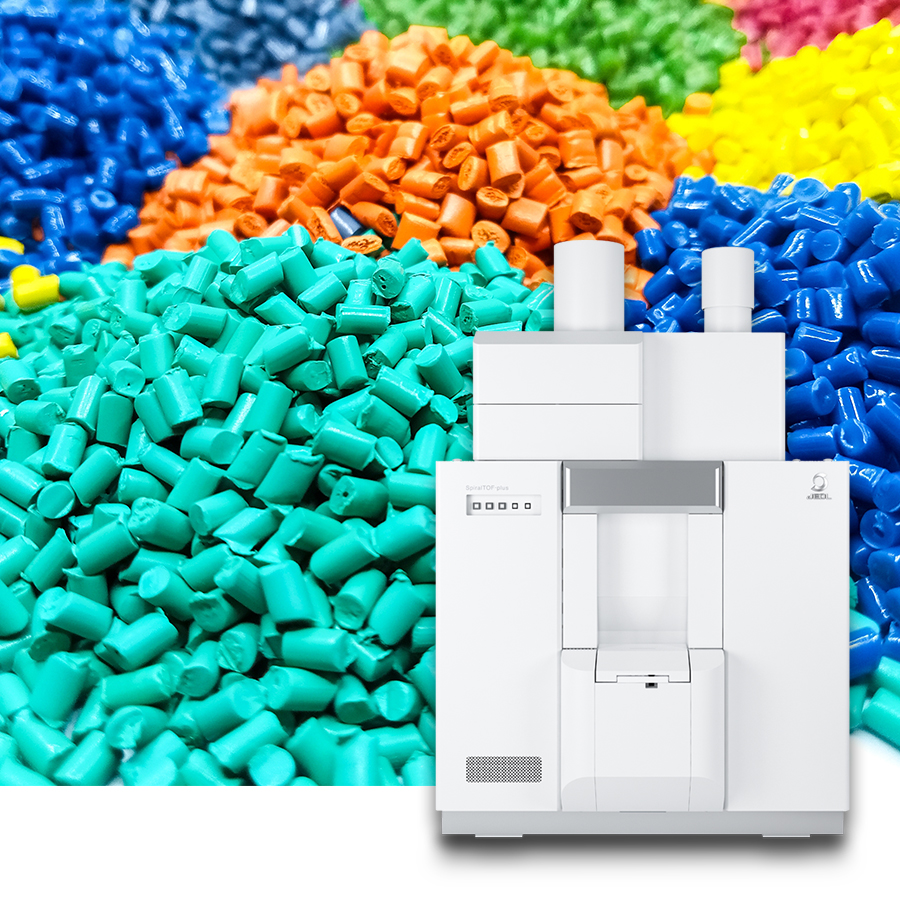
JMS-S3000 SpiralTOF™-plus 3.0 Polymer Analysis System
The combination of the JMS-S3000 SpiralTOF™-plus 3.0's high mass resolution, high mass accuracy, and wide dynamic range with the msRepeatFinder polymer analysis software makes it the most powerful polymer analysis system.
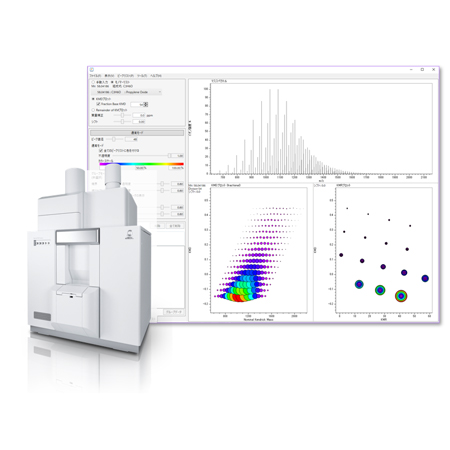
msRepeatFinder (Option)
The Kendrick Mass Defect (KMD) plot and the Kendrick Mass Remainder (KMR) plot are used to estimate the polymer species and end groups contained in polymer materials from a complex mass spectrum and clarify their identity. In addition, the differential analysis function between two samples is effective in verifying sample degradation, lot-to-lot differences, and differences in the synthesis process.
Evolving mass imaging analysis
MALDI MS imaging was initially developed to focus on high molecular weight compounds such as proteins and peptides. However, with the expanding applications of MALDI MS imaging, the interests have shifted to include smaller molecules such as lipids, pharmaceuticals, and pharmaceutical metabolites. Conventional MALDI - reflectron TOFMS has difficulty discerning small molecule signals from those of matrix. In the case of MALDI MS imaging, signals from unwanted molecules on the specimen surface will often interfere with signals from the target analytes. High selectivity by means of high mass-resolving power is essential for obtaining reliable target analyte spatial distributions. It is also important to maintain high mass-resolution and mass-accuracy for a long time even when measuring a sample surface with a large area and non-uniformity. SpiralTOF™-plus 3.0 is the only MALDI-TOFMS that meets imaging requirements with ultra-high mass-resolution and long flight distance to minimize loss of mass resolution due to sample surface non-uniformity. In addition, it also supports high-speed mass imaging analysis.
FINE-AI Filter: Noise Filtering Using AI (Machine Learning) Technology
Our newest MS imaging data processing software msMicroImagerTM version 3 (optional) is now equipped with FINE-AI Filter, a noise filtering technology that uses AI (machine learning). This new FINE-AI Filter originates from the JEOL LIVE-AI (Live Image Visual Enhancer-AI) technology developed for our scanning electron microscopes (SEM), which was re-optimized for MS imaging and implemented to achieve significant improvements to the quality of MS images.
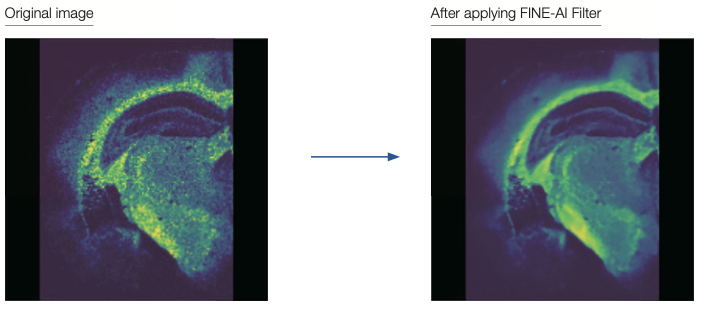
Mass Spectrometry Imaging Analysis of Lipids in Mouse Brain Tissue Section
Mouse brain sections contain a variety of lipid classes. A mass spectrum obtained from a tissue section is highly complex, especially in the region of m/z 700 - 1,000. Many of the peaks in the mass spectrum are less than 10% of the base peak, representing minor components. MALDI MS imaging of lipids requires a mass-resolving power high enough to separate the minor peaks from interferences. The bottom mass spectrum below shows the expansion of m/z 820 - 823. Many peaks were separated from each other by less than 0.1 u. The high mass-resolving power of the SpiralTOFTM-plus 3.0 clearly separated these isobaric peaks, thus allowing the elucidation of 4 lipid elemental compositions. Moreover, each lipid clearly showed a different spatial distribution. Elucidation of elemental compositions and accurate determination of spacial distributions for each lipid would be difficult with a conventional reflectron TOFMS with moderate mass-resolving power.
By applying the AI noise filter, FINE-AI Filter, MS images of even higher quality can be obtained.
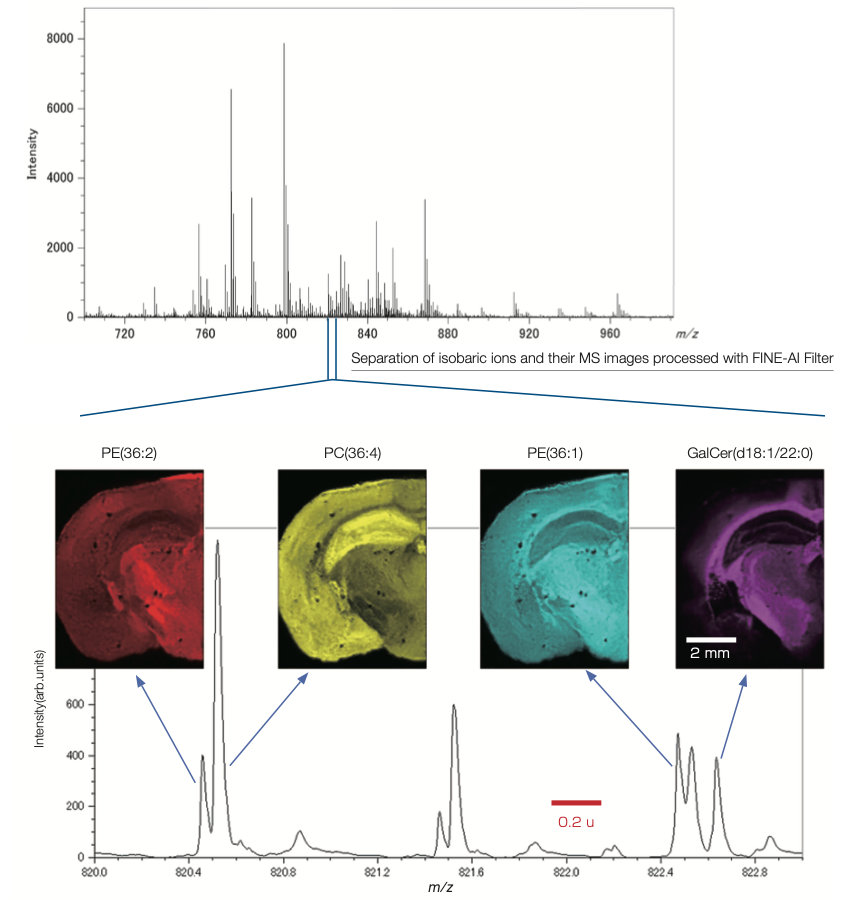
PE: Phosphatidyl ethanolamine, PC: Phosphatidyl Choline, GalCer: Galactosylceramide<br>This data was acquired in a joint research project with the Mass Spectrometry Group, Project Research Center for Fundamental Sciences, Graduate School of Science, Osaka University.<br>The tissue section specimen was provided by Awazu Laboratory, Division of Sustainable Energy and Environmental Engineering, Graduate School of Engineering, Osaka University.
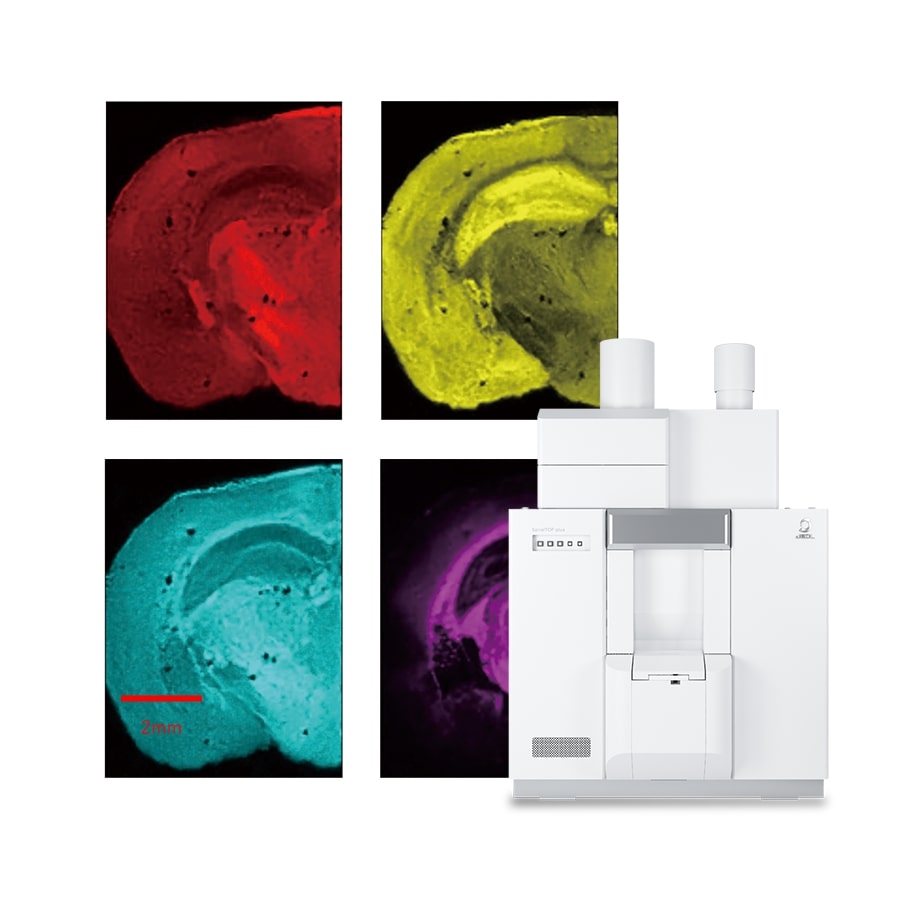
JMS-S3000 SpiralTOF™-plus 3.0 Mass Spectrometry Imaging System (Option)
JMS-S3000 SpiralTOF™-plus 3.0 Mass Spectrometry Imaging System
Analysis of proteins
Mass spectrum of the tryptic digest of bovine serum albumin (BSA) and the results of the peptide mass fingerprinting.
Peptide mass fingerprinting (PMF) is effective for identifying proteins isolated by two-dimensional electrophoresis. The isolated protein is digested by a protein-digesting enzyme such as trypsin, and the protein is identified by comparing the mass spectrum of the resulting peptide mixture with information in a protein database. The high mass accuracy of Spiral mode makes it possible to set an extremely narrow mass tolerance range during database matching, enabling highly reliable identification with fewer false positives.
Mass spectrum of BSA tryptic digest standard (equivalent to 500 amol)

| Amount (fmol) | Number of peptides matched/searched | Sequence coverage (%) | MASCOT score |
|---|---|---|---|
| 50 | 52 / 81 | 75 | 570 |
| 10 | 41 / 79 | 64 | 390 |
| 5 | 36 / 77 | 54 | 351 |
| 1 | 28 / 57 | 43 | 255 |
| 0.5 | 31 / 52 | 46 | 306 |
| 0.1 | 12 / 34 | 18 | 92 |
3D-structure of RCSB PDB (www.rcsb.org) ID 1IGY (Harris, L.J., et al. (1998) J.Mol.Biol. 275: 861-872) created with Protein Workshop (Moreland, et al. (2005) BMC Bioinformatics 6:21).
Identification of Bovine Serum Albumin (BSA) by MS/MS Ion Search Method
When it is diffi cult to isolate a protein, identifi cation using the MS/MS Ion Search method is eff ective. The entire procedure of measuring
a standard BSA tryptic digest in Spiral mode, selecting the 10 most intense ions in the measured mass spectrum as precursor ions, and
measuring each product ion mass spectrum was performed automatically. When an MS/MS Ion Search using a MASCOT Server was
performed for the 10 product ion mass spectra, BSA was identifi ed with high confi dence.
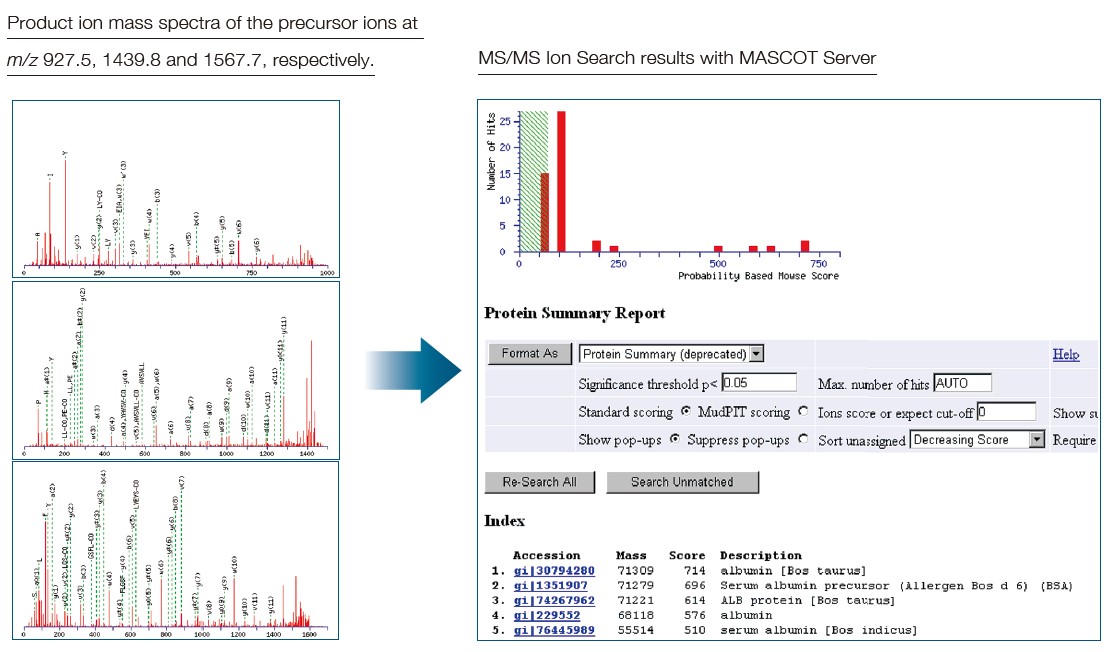
Confirmation of Synthetic Oligonucleotides
Accurate confi rmation of synthetic oligonucleotides is important in the development and manufacturing of nucleic acid drugs. A synthetic oligonucleotide 5’-CGCTAAGTACGCAATGGGCC-3’ consisting of 20 bases was measured in Linear, positive ion mode and Spiral, positive ion mode. In Spiral mode, the protonated molecule [M+H]+ was observed with a mass resolution of over 40,000, with a mass measurement error of -6.4 mDa (-1.0 ppm) using the external standard method, supporting the expected elemental composition.
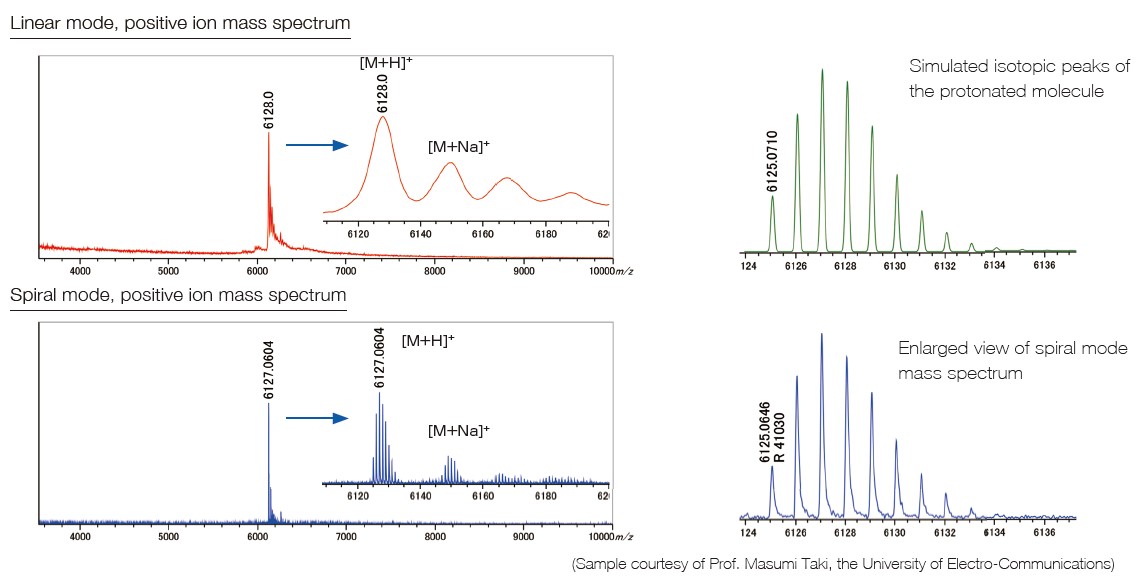
Structural Analysis of Oligosaccharides
High-energy collision-induced dissociation (HE-CID) tandem mass spectrometry (MS/MS) allows the identifi cation of structural isomers of oligosaccharides. Laminaritetraose and stachyose are tetrasaccharides that are structural isomers of each other. The product ion mass spectra were measured using the TOF-TOF option with sodiated molecule [M+Na]+ as the precursor ion. Although almost all product ions are common, the relative intensities of m/z 671, 658, and 599 are uniquely strong for stachyose. This is thought to refl ect the structural stress and steric hindrance unique to the 5-membered ring fructose at the reducing end of stachyose.
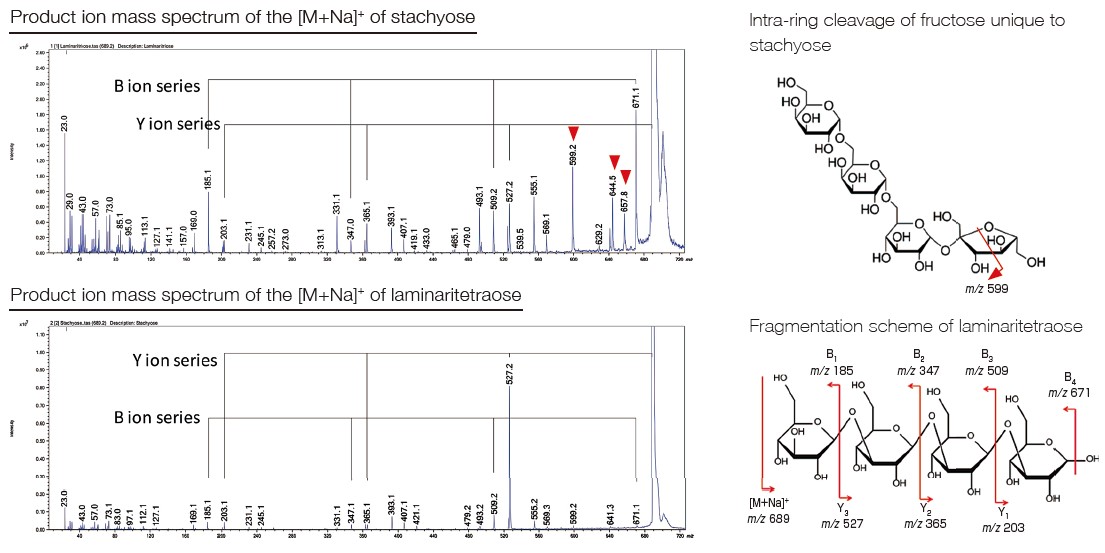
Structural Analysis of Phospholipids in Hen Egg Yolk
Lipids in hen egg yolk were extracted and analyzed in positive ion mode. A variety of phosphatidylcholines (PCs) were detected in the sample. In the example below, the product ion mass spectrum from the protonated molecule [M+H]+ was acquired for PC (34:1). Product ions derived from the fragmentations within the fatty acid chains were observed, which provided the information necessary for determining the fatty acid composition and double bond position.
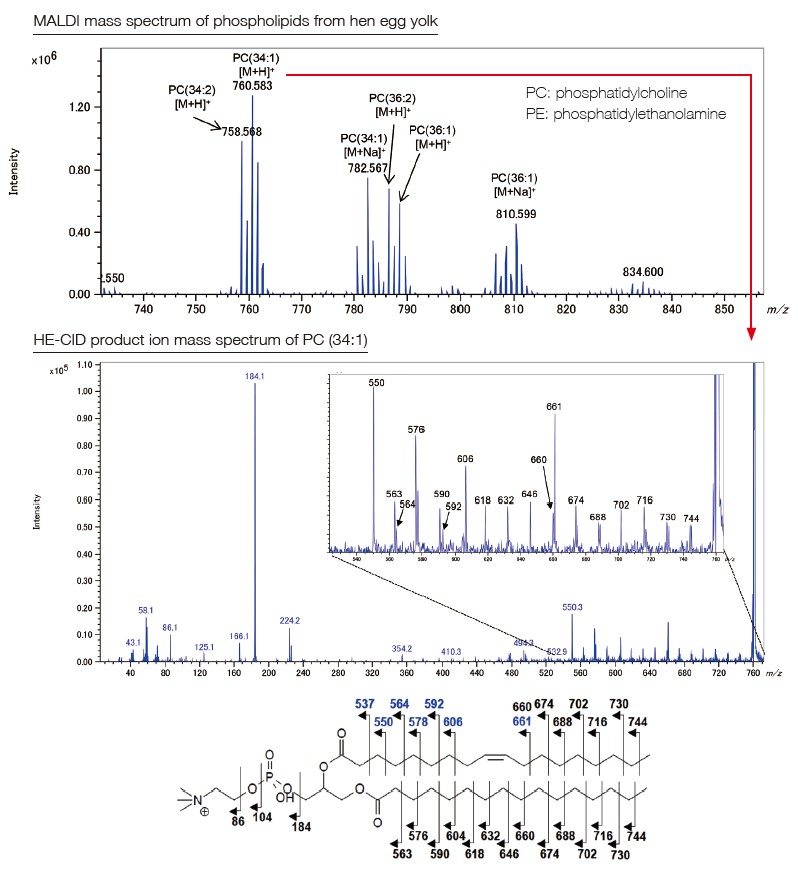
Accurate Mass Measurements of Synthesized Organic Compounds
Previously, MALDI-TOFMS systems were not suitable for the analysis of small molecules as matrix-derived peaks and continuous chemical noise interfere with the signal from analyte molecules. The SpiralTOF ion optics have solved these problems.
Analysis of a common cold medicine
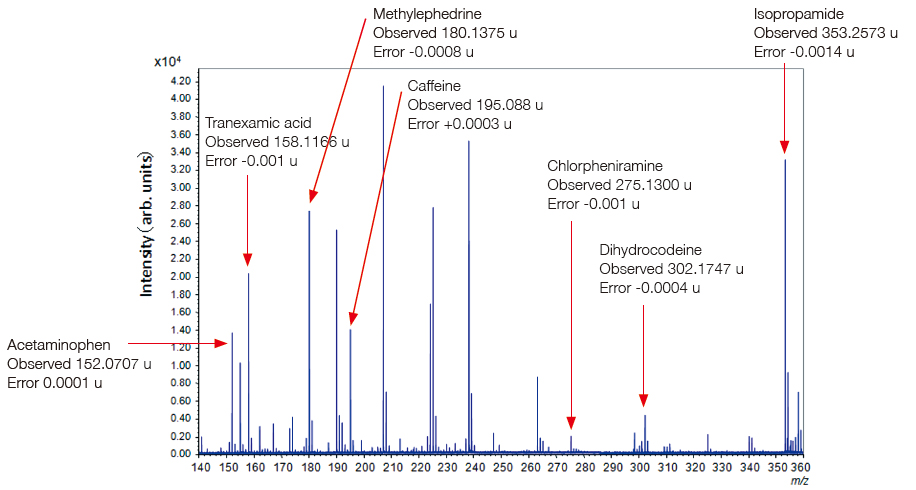
Analysis of Boroxin Cage 12-mer
Isotopic peaks are completely separated in the high-mass region due to the ultra-high mass resolving power of Spiral mode. For high molecular weight compounds, the abundance of the monoisotopic ions are very small and diffi cult to observe. The elemental composition of the molecule can be confi rmed by the observed m/z of the most-abundant ion and/or comparing the isotopic peak pattern with that of the simulation.
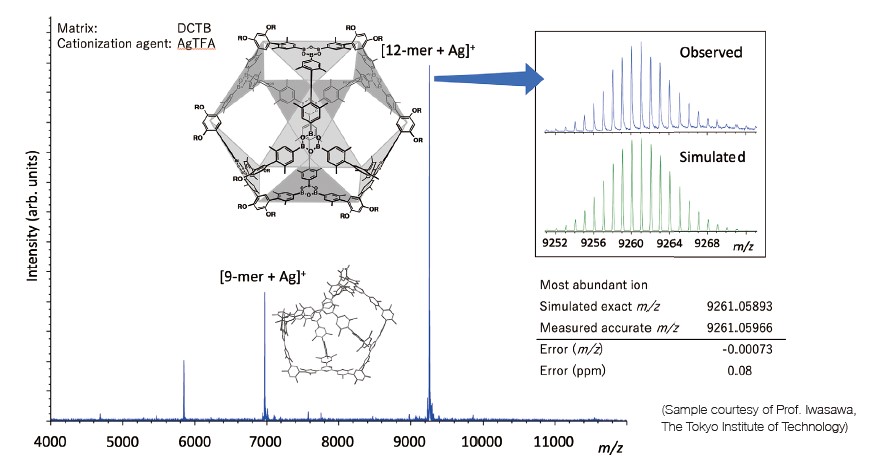
Self-Assembly of Nanometer-Sized Boroxine Cages from Diboronic Acids, Ono, K., et al., J. Am. Chem. Soc. 2015, 137 (22), 7015-7018, DOI: 10.1021/jacs.5b02716
Catalogue Download
Related Products
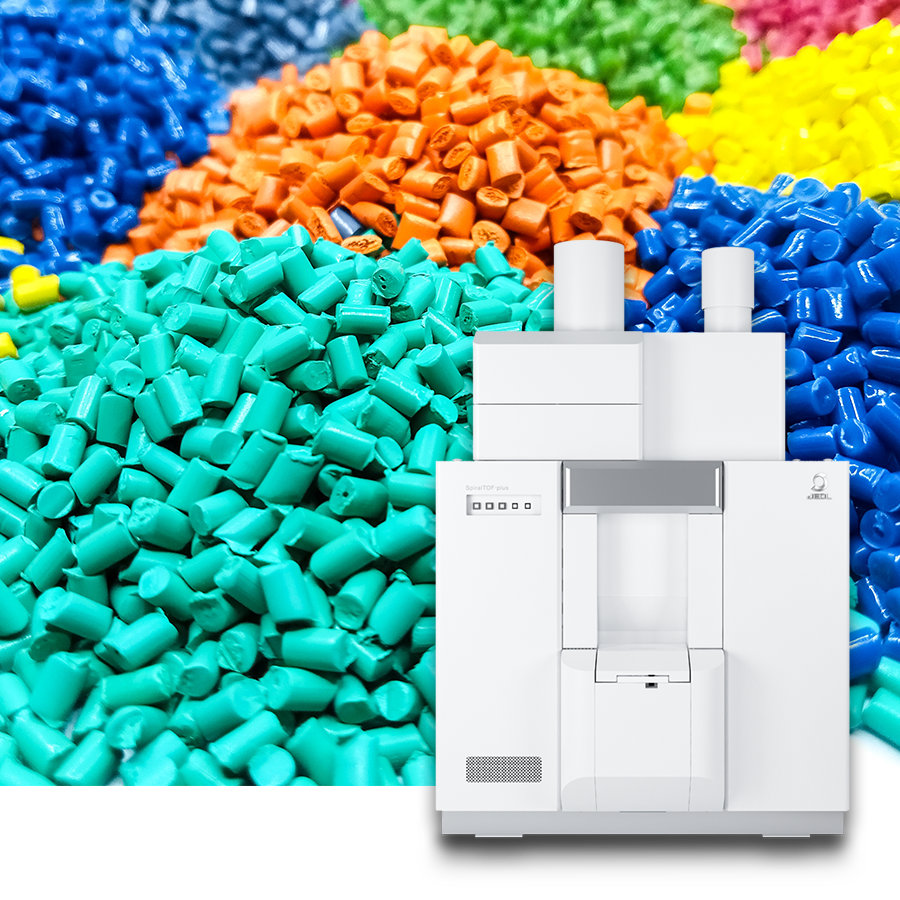
JMS-S3000 SpiralTOF™-plus 3.0 Polymer Analysis System
The combination of the JMS-S3000 SpiralTOF™-plus 3.0's high mass resolution, high mass accuracy, and wide dynamic range with the msRepeatFinder polymer analysis software makes it the most powerful polymer analysis system.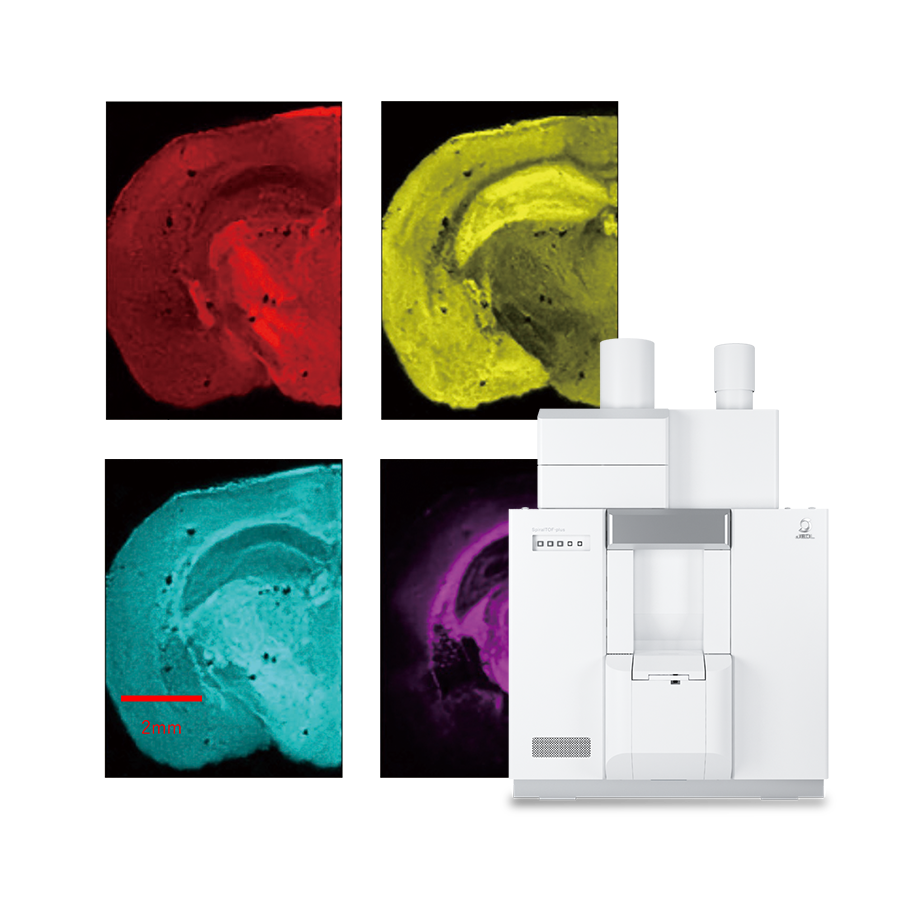
JMS-S3000 SpiralTOF™-plus 3.0 Mass Spectrometry Imaging System
◆Click the play button in the above box to watch the video. (3min 30sec.)◆
Applications shown in the movie:
Distribution of lipids (phospholipids and fatty acids) in thyroid cancer tissues
Mass spectrometry imaging on mixed conductive/non-conductive substrate using JMS-S3000 SpiralTOF™
Other mass spectrometry imaging applications are here.
More Info
Are you a medical professional or personnel engaged in medical care?
No
Please be reminded that these pages are not intended to provide the general public with information about the products.
